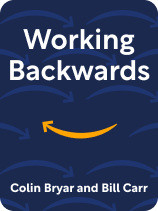

This article is an excerpt from the Shortform book guide to "Working Backwards" by Colin Bryar and Bill Carr. Shortform has the world's best summaries and analyses of books you should be reading.
Like this article? Sign up for a free trial here.
How does the Working Backwards book describe Amazon’s guiding principles and strategies? What tools do the authors present as Amazon’s keys to success?
In Working Backwards, authors Colin Brayr and Bill Carr describe how Amazon’s tools like the deep thinking document, the six-pager, and a rigorous hiring process have helped it get ahead in the industry. Learning more about these strategies can help strengthen and grow any business.
Keep reading to learn about the tools and strategies that have led Amazon to success.
About Working Backwards
If you want to start a successful business, many would argue that Amazon is the one to imitate. In just a few decades, Amazon has grown from an obscure internet startup to a household name, raking in hundreds of billions of dollars by offering a vast range of products and services. Authors Colin Bryar and Bill Carr explain exactly how Amazon achieved its meteoric growth and argue that any company can follow in its footsteps in its Working Backwards book.
In Working Backwards, Amazon insiders Bryar and Carr detail the specific guiding principles and business practices that Amazon used to become such a dominant force in so many industries. Bryar worked as Chief of Staff to Amazon founder Jeff Bezos for two years, picking up many of Bezos’s business management strategies. Carr served as Amazon’s Vice President of Digital Media, where he was directly responsible for the success of projects such as Amazon Music and Prime Video.
We’ll begin this article by examining the broad strategy behind Amazon’s success—articulate the internal culture you want, then design your business in a way that encourages this culture. Then, we’ll get specific, discussing the tools Amazon uses to create its culture of success: first, the processes Amazon uses to develop successful business strategies, then those they use to build productive teams.
In our commentary, we’ll expand on Bryar and Carr’s advice with relevant tips from business books like What You Do Is Who You Are and The Lean Startup. We’ll also offer counterpoints to Amazon’s business philosophy with alternative strategies from books like Range and It Doesn’t Have to Be Crazy at Work.
How Amazon Established a Culture of Success
According to Bryar and Carr, Amazon is more successful than other, more traditional businesses because they consistently do things differently than traditional business wisdom would dictate. Consistently doing things differently is more difficult than it sounds. As a company grows, it becomes impossible for one leader to directly ensure that workers throughout the organization persistently follow an unconventional path to success.
Amazon’s Primary Guiding Principle
What specific principles does Amazon use to remain such a success? Bryar and Carr assert that Amazon’s foremost guiding principle is that providing a valuable, satisfying customer experience is the company’s top priority. The authors contend that Amazon’s success is largely due to founder Jeff Bezos’s insistence that the surest way to maximize revenue is to provide the most value to customers in the long term.
In practice, Amazon employees apply this guiding principle by working backwards—first, they identify the valuable experience they want to provide to customers. Then, they seek out the resources and skills they need to provide that experience and develop a strategy to create that experience.
Amazon’s Tools for Strategy Development
We’ve established that Amazon found success by specifying guiding principles and designing the company in a way that aligned with those principles. For the rest of this guide, we’ll explain this second part in more detail—how Amazon designed their company’s business practices to reinforce their principles. Some of these practices are meant to encourage Amazon employees to work backwards, while others are meant to reinforce some of Amazon’s other important guiding principles.
In this section, we’ll discuss four tools Amazon’s workers use for strategy development; that is, to identify what to do to succeed. This not only includes tools to help them envision the customer experience (working backwards) but also tools to help them create and refine the customer experience after they’ve defined it.
- Tool #1: The Product Development Proposal
- Tool #2: The Deep Thinking Document
- Tool #3: The DMAIC Process
- Tool #4: Big-Picture Planning
Tool #1: The Product Development Proposal
The first tool we’ll discuss is what we call the Product Development Proposal (PDP). As Bryar and Carr explain, this is a type of document Amazon uses to apply the guiding principle of prioritizing the customer experience when coming up with new product ideas. Any team with an idea for a new customer-facing product must create a PDP before starting work on it.
Bryar and Carr state that the document consists of two parts: a press release and a set of frequently asked questions. (For this reason, Amazon refers to the Product Development Proposal as the “PR/FAQ.”)
Section #1: The Press Release
Amazon employees begin writing the PDP by imagining the product they want to create in its final form and writing a hypothetical press release unveiling this new product to the public. This press release describes what the product is and the range of benefits it offers to the customer. Articulating a clear vision of the final customer experience they want to deliver is a way for the team to work backwards and figure out what they need to do to get there.
Section #2: Frequently Asked Questions
The second half of the Proposal is a list of answers to “frequently asked questions”—more accurately, these are questions that the writer anticipates their coworkers and customers will have about the product, according to Bryar and Carr. In answering these questions, the writer explains how much they expect it will cost to develop their hypothetical product, the challenges the team needs to overcome to do so, and any other information they think executives will need before greenlighting the product.
Tool #2: The Deep Thinking Document
Next, let’s discuss a tool we’ll call the Deep Thinking Document (DTD). Whenever an Amazon employee wants to propose any course of action, they’re expected to write a detailed argument in a DTD rather than present it in a slideshow presentation. Similar to the PDP, the DTD serves as the central focus of group meetings. However, Amazon employees use DTDs in practically every meeting about anything in the company, not just product development—for example, proposed process improvements or budget changes. (At Amazon, this document is known as the “Six-Pager.”)
How the Deep Thinking Document Works
Over time, Amazon employees discovered that traditional slideshow presentations made it difficult for meeting participants to understand and accurately judge the ideas being presented. As a medium, slideshows can only convey very basic ideas. Slides lack the space necessary to convey complex ideas via text, and the linear presentation of slides makes it difficult to illustrate how a web of ideas connect.
According to Bryar and Carr, the DTD solves the problems with slideshows: Detailed text documents give presenters the space they need to fully explain complex concepts. Additionally, Amazon employees dedicate the first several minutes of any meeting to a silent read-through of the presenter’s DTD. This allows all meeting participants to engage with the presenter’s ideas nonlinearly, flipping through the document at their own pace—which enhances their understanding—rather than passively listening to the ideas just once from beginning to end.
Tool #3: The DMAIC Process
The next tool we’ll discuss is the DMAIC process—Amazon’s five-step procedure for evaluating progress and discovering business solutions. DMAIC is an acronym for Define, Measure, Analyze, Improve, Control—the five steps to improving any part of your business. Amazon didn’t invent this process; rather, they adopted it from a set of business practices invented in the 1980s called Six Sigma.
Let’s take a look at each step of the DMAIC process, spending a bit more time on step one (which is more complex), then briefly covering the other four steps.
Defining Your Metrics
Bryar and Carr assert that Amazon uses the DMAIC process to implement its principle of prioritizing the customer experience and working backwards, as we can see in step one: Define.
Specifically, define a set of metrics to track and optimize that accurately represent the quality of the customer experience. In other words, you must identify ways to assess how well you satisfy customers before working backwards to figure out how to satisfy customers even more (in the rest of the DMAIC process). These metrics should be quantitative—expressible in numerical data—so you can analyze them clearly and precisely. For example, if you’re managing a fast food restaurant, one of the metrics you define could be “average time between customer order and food delivery.”
Additionally, Bryar and Carr stress that the metrics you define should be input metrics rather than output metrics. In other words, focus on aspects of your business you can directly control rather than those you can’t. Speed of food delivery, as in the example above, would be an input metric, while statistics like your total number of customers or percentage of five-star user reviews would be output metrics.
Measure, Analyze, Improve, Control
As Bryar and Carr explain, after you define your metrics, step two of the DMAIC process is Measure: Set up tools for continually gathering data on the metrics you’ve defined. Step three is Analyze: Identify all the determining factors that influence your input metrics. Then, Improve: Change the determining factors you’ve identified in a way that improves your metrics. Finally, Control: Monitor your improved processes and make sure your input metrics don’t show signs of backsliding.
Let’s return to our restaurant example. If you’ve defined one of your restaurant’s input metrics as the speed of food delivery, the last four steps of DMAIC might look like this:
- Measure: You create software that automatically times how long it takes for your fast food employees to cook and serve each meal.
- Analyze: You discover that the speed of food delivery depends on how long the food takes to prepare and how busy the restaurant is.
- Improve: You simplify the recipe of your most popular menu item to shorten the time it takes to prepare.
- Control: You continue monitoring your food delivery speed and investigating if it ever slips up.
Tool #4: Big-Picture Planning
The last of the strategy development tools we’ll be discussing is the big-picture planning process. Bryar and Carr explain that this is the procedure Amazon uses twice a year to determine what universal company goals all employees should prioritize.
First, the highest-level executives in the company set some broad goals that all teams in the company can collectively work toward; for instance, for the company to earn a certain amount of revenue this year. Then, leaders from each team write DTDs proposing numerous strategies and projects—the ways their specific team will help the company reach its goals in the coming year. In these narratives, they formally request the funds and other resources they need to accomplish their goals.
Last, executives review these proposals, and the highest-level executives choose a certain number of them for each team to prioritize over the others. For example, if a marketing team proposes a social media advertising campaign, a new email newsletter, and a partnership with a YouTube influencer, the executives might approve all three goals but request that the team prioritize the email newsletter.
Amazon’s Tools for Building Productive Teams
So far, we’ve discussed a handful of tools that Amazon uses to rapidly develop strategies with the greatest chance of success. In the final section of this guide, we’ll explore two more tools Amazon uses for consistent success—this time, tools that Amazon uses to build productive teams that can execute the strategies they develop. These tools are meant to reinforce more of Amazon’s guiding principles.
- Tool #1: Rigorous Hiring Process
- Tool #2: Single-Responsibility Teams
Tool #1: Rigorous Hiring Process
The first tool for building teams we’ll discuss is Amazon’s uniquely rigorous hiring process. Amazon strives to perfect their hiring process because of another one of their guiding principles: Only hire applicants with the potential to be better than the existing team.
According to Bryar and Carr, hiring top talent is important because the quality of new hires determines your organization’s culture. As your company grows, new hires will quickly outnumber veteran team members and make up the vast majority of the team. If your lenient hiring process leads to new hires with low standards for their work, it can create a permanent culture of low standards across the organization.
Tool #2: Single-Responsibility Teams
The second and final tool for building teams is what we’ll call single-responsibility teams (what Bryar and Carr refer to as “the single-threaded leader model”).
What are single-responsibility teams? Generally, teams at Amazon only work on a single mission; for instance, to expand the business into foreign markets, or to operate and improve a customer service hotline. Each single-responsibility team has a single-responsibility leader whose only job is to lead the team to accomplish its mission. Bryar and Carr argue that this narrow focus ensures that every team accomplishes what it sets out to do.
Exercise: Compare Your Organization to Amazon
In Working Backwards, Bryar and Carr offer a very specific model of a successful company. Consider how your organization compares.
- First, think about what Amazon does better than your organization: Which of their tools would have the greatest positive impact on your organization if implemented, and why? Describe how different your organization would look after implementing this tool. (For example, perhaps your organization runs ineffective meetings and would benefit from integrating Deep Thinking Documents. By skipping unfocused presentations, workers at your organization could save time and avoid having to work late.)
- What parts in your organization work better than the tools Bryar and Carr suggest? What could you do to better utilize or improve those strengths? (For example, maybe workers at your company are unusually familiar, trusting, and collaborative. You could leverage this strength by giving subordinates more authority to start collaborative projects.)
- What aspect of your organization most closely resembles Amazon (as Bryar and Carr describe it)? How could you tweak that part of your organization to be even better? (For example, if your company already has a rigorous hiring process involving multiple interviewers, perhaps you could make it more objective by requiring interviewers to write down their opinions before discussing the applicant with each other.)

———End of Preview———
Like what you just read? Read the rest of the world's best book summary and analysis of Colin Bryar and Bill Carr's "Working Backwards" at Shortform.
Here's what you'll find in our full Working Backwards summary:
- How any company can grow the same way Amazon did
- How Amazon rapidly scaled its startup into an online empire
- The four tools Amazon’s workers use for strategy development






